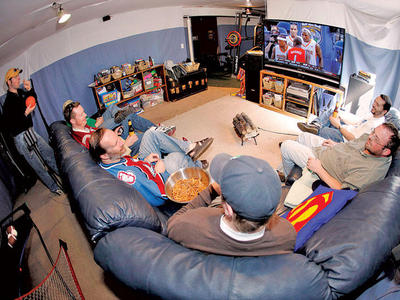 The finished basement remodeling is almost done. It's your Man Cave...decked out with large screen TV, bar, and recliners. You can't wait, watching the next game with the guys, your Sunday sports haven 'downstairs' in your own private space.
The finished basement remodeling is almost done. It's your Man Cave...decked out with large screen TV, bar, and recliners. You can't wait, watching the next game with the guys, your Sunday sports haven 'downstairs' in your own private space.
But then you notice moisture seeping in around parts of the new drywall. Nuts! The only place you thought there would be water was at your new wet bar!
You Can Keep Moisture from Ruining Your New Walls
Basement remodeling is popular in Central New York. But now that we are creating living spaces in portions of the home that once were storage areas, we need to consider how the enclosing and tightening up of these spaces effect our overall structure. Do "old school rules of thumb" work or should we consider more advanced calculations to make the space work? That's the question when homeowners have had vapor barriers (more correctly called vapor diffusion retarders) installed to keep their remodeled basements dry.
The thing about construction in the northern climes is that with the changing seasons, the temperature drastically fluctuates. As anyone living in Upstate New York can attest, temperatures during the year can range anywhere from -20° to up to 100°. This makes it important to install the right vapor barrier in the right place.
The Residential Code of New York State describes three classes of water vapor retarders based on their ability to retard the diffusion of water as measured in units know as "perms" or permeability: Class I vapor retarders allow less than 1 perm, Class II between 1 and 10 perms, and Class III greater than 10 perms.
I've seen problems when a Class I vapor barrier (in this case a sheet polyethylene) was directly applied to the interior side (warm side) of a poured concrete foundation wall. To compound the problem fiberglass insulation with a Class II (kraft faced) vapor retarder was placed within the 2 x 4 finished wall next to the concrete wall.
What happens here is the water vapor becomes trapped between the two vapor retarders, then condenses on the coldest surface (the polyethylene sheet attached to the cold foundation wall) and becomes visible water.
The Quick and Easy Way for a Dry Man Cave
The way to keep your interior space dry is to calculate the dew point within a space to determine the right class of vapor barriers and the best place to install them. The dew point (the point where the surrounding air becomes saturated with water vapor and condenses) in places like Florida is more consistent from home to home because the temperature stays relatively the same throughout the year.
But here in the Mohawk Valley, controlling water vapor becomes a little bit more problematic because temperature fluctuates so much with the changing seasons. The dew point calculation considers the average interior temperature of your house and the average exterior temperature of our area from December through February.
Your architect can perform this calculation before finished construction begins so you can avoid costly moisture damage, mold, and the resultant repair costs later. Once the dew point and the appropriate vapor barrier are determined, your construction project can begin.
I've been an architect for over 20 years and have seen lots of water damage. Let's be sure the only water you experience in your finished basement is from that nice, new wet bar and not condensation on the new walls.
By the way, you can get more valuable info on vapor diffusion retarders here at Energy.gov.
Until next time,
Dan Berkhoudt, Architect/Owner




Leave a Comment